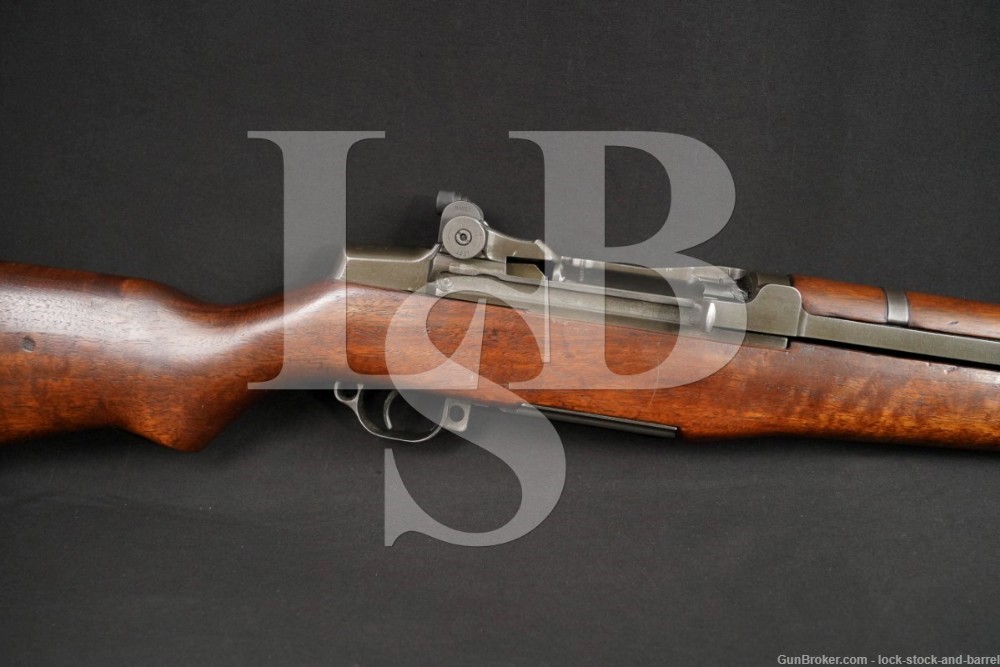
WWII Winchester M1 Garand US NM Sights .30-06 Semi Automatic Rifle C&R
SOLD FOR: $1625
LSB#: 220425JT002
Make: Winchester
Model: M1 Garand
Serial Number: 2337187
Year of Manufacture: August, 1944 (page 186 of Joe Poyer’s M1 GARAND 1936 to 1957, 6th Edition). Barrel Date: November, 1952
Caliber: .30-06 Springfield
Action Type: Semi Auto, En Bloc Clip Fed
Markings: There is no import mark.
Receiver: “U.S. RIFLE / CAL. .30 M1 / WINCHESTER / TRADE MARK / 2337187”
Trigger Group: “D28290-12-SA”- A Springfield part (page 90 of Joe Poyer’s M1 GARAND 1936 to 1957, 6th Edition).
Hammer: “C46008–2 SA” – A Springfield part (page 98).
Safety: “C46015-9SA” – A Springfield part (page 103).
Follower: “12” – A Springfield part (page 83).
Receiver Leg: “D 28291-2” –Correct for the Winchester serial number (page 757 of Bruce Canfield’s book, The M1 Garand Rifle).
Op Rod: “D35382 SA.” – A Springfield part (page 71).
Barrel: “P”, “LMR” (Line Material Company of Birmingham, Alabama), “D6535448”, “11 52”, and with a “crossed cannons” cartouche – LMR provided barrels for International Harvester and Harrington & Richradson (pages 63 – 65).
Bolt: “D6528287 IHC / .U.” – An International Harvester part (page 53).
The stock and sights are described below.
Barrel Length: Approximately 24 Inches
Sights / Optics: The rifle has National Match (NM) sights installed. The front sight is marked “NM 062”. The rear sight riser is marked “NM” and the top of the aperture is marked “520”. The rear sight wing is marked “NM/2A”. The rear windage knob is marked “NM 25507”.
The front sight is a blade set between two protective wings. The rear sight is a fully adjustable aperture sight set between two protective wings. The windage knob is marked “left arrow” twice. The elevation knob is marked from “2-12” in increments of two and “BS”.
Stock Configuration & Condition: The face of the grip is marked with a “circled P” proof. The left side of the stock, above the trigger, is marked with a Springfield Armory Inspector’s cartouche “S.A. / J.L.G. in a box”.
The hardwood stock has a pistol grip, metal nose caps, stacking loop, two sling loops and a metal buttplate with hinged door for storage in the butt. The buttplate has been painted. The paint shows scrapes & light thinning. The wood shows several scrapes, scratches and compression marks. Some have damaged small portions of the surface wood. These marks have been oiled. The LOP measures 13 1/8 inches from the front of the trigger to the back of the buttplate. The stock rates in about Very Good overall condition.
Type of Finish: Parkerized
Finish Originality: Original to Rebuild
Bore Condition: The muzzle & grooves are light gray and the rifling is deep. There is fouling and intermittent light erosion at the muzzle and in the grooves. The fouling should clean up some. There is frosting near the muzzle. The bore shows an M.E. of 1.2. The throat shows a T.E. of 4.5.
Overall Condition: This rifle retains about 96% of its metal finish. The bottom rear of the receiver shows light thinning. The left rear of the receiver has small scratches & dents showing through the new finish. The metal shows scuffs, scrapes and small scratches. The receiver and bolt show light operations wear. The rear sight and receiver have small paint markings on them for a sight zero. Most of the markings are clear. Overall, this rifle rates in about Very Good Plus condition.
Mechanics: The action functions correctly. We have not fired this rifle. As with all previously owned firearms, a thorough cleaning may be necessary to meet your maintenance standards.
Box, Paperwork & Accessories: None
Our Assessment: Our Assessment: The U.S. Rifle, Caliber .30, M1 is known affectionately as “the Garand” after its inventor, John Garand. The rifle would become the first standard-issue semi-automatic infantry rifle in the world. While some countries entered the war with limited issued semi-automatic rifles or developed such rifles during the war, America was the only nation to enter with its Army issuing autoloading rifles on a large scale. General Patton famously referred to the rifle as “the greatest battle implement ever devised”. Millions were produced during WWII and hundreds of thousands afterward, seeing use through the Korean War and into the Vietnam War. Interestingly, while many other weapons and military items would see production contracts sent out to otherwise non-related companies, during WWII production remained with Springfield Armory and Winchester. It was only after the war that production would be contracted out to another gunmaker, Harrington & Richardson, as well as the agricultural equipment maker, International Harvester.
This M1 Garand was made Winchester back in 1943. It has since been rebuilt using a mix of USGI parts. It has National Match sights installed and uses an LMR barrel. LMR provided barrels for International Harvester and Harrington & Richradson. LMR Barrels are considered to be high quality M1 Garand barrels. The rifle was refinished when it was rebuilt so it looks impressive for a WWII service rifle. This Winchester M1 Garand will add to your WWII collection and should be able to ring plenty of steel out at the range. Good luck.

